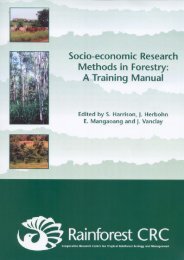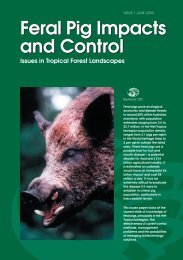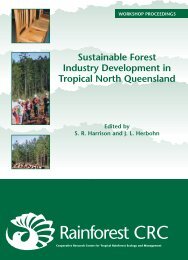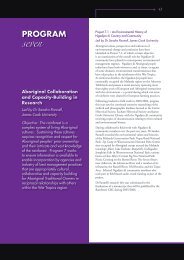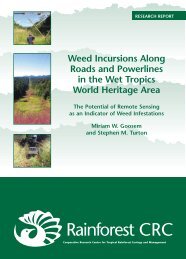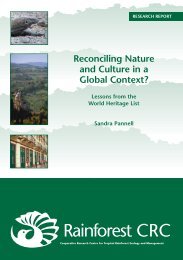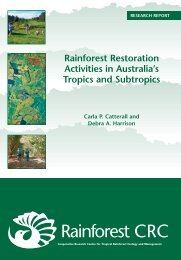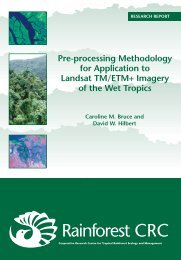Reconciling Nature and Culture in a Global Context? - Rainforest ...
Reconciling Nature and Culture in a Global Context? - Rainforest ...
Reconciling Nature and Culture in a Global Context? - Rainforest ...
You also want an ePaper? Increase the reach of your titles
YUMPU automatically turns print PDFs into web optimized ePapers that Google loves.
S<strong>and</strong>ra Pannell<strong>in</strong>troduces a new role for the National Park as a “genetic / species storehouse with which toreplenish <strong>and</strong> recolonise devastated coral habitats elsewhere <strong>in</strong> Indonesia <strong>and</strong> the widerIndo-Pacific region” (S<strong>in</strong>gleton et al. 2002: 8). TNC’s promotion of Komodo National Park asan “exceptional storehouse of both terrestrial <strong>and</strong> mar<strong>in</strong>e biodiversity” (ibid: 3) signals the“conversion of nature <strong>in</strong>to an accumulation strategy” (Katz 1998: 47). In keep<strong>in</strong>g with thelogic of corporate environmentalism, biodiversity is depicted as an ‘asset’, while nature isreferred to as a ‘bank’ or ‘fund’ where organisations like TNC make ‘sensitive’ <strong>and</strong>‘susta<strong>in</strong>able’ <strong>in</strong>vestments (see S<strong>in</strong>gleton et al. 2002).In this more <strong>in</strong>clusive view of nature, <strong>in</strong>troduced animals <strong>and</strong> translocated native species,such as wild boar, Timor deer, horses, buffalo, macaques, as well as <strong>in</strong>troduced plantspecies, are all regarded as part of the Park’s ‘rich biodiversity’, <strong>and</strong> thus afforded protection.It is apparent from the plan that Homo sapiens is not regarded as part of the region’sbiodiversity. Interest<strong>in</strong>gly, dogs <strong>and</strong> cats, both of which are l<strong>in</strong>ked to the local residents <strong>in</strong>the Park, are the only animals identified <strong>in</strong> the management plan as ‘exotics’ that pose athreat to the biodiversity of the region (PHKA <strong>and</strong> TNC 2000, Vol. 1: 21, Vol. 2: 67) 34 . Asstated <strong>in</strong> the 2000 plan, one of the primary objectives of management is to “reduce boththreats to the resources <strong>and</strong> conflicts between <strong>in</strong>compatible activities” (PHKA <strong>and</strong> TNC 2000,Vol. 1: 5). As these comments suggest, the re<strong>in</strong>vention of the Komodo archipelago as anarea of “rich biodiversity”, with one of the “world’s richest mar<strong>in</strong>e environments” (TNC n.d. b:1), has serious consequences for local people.CULTURE WARS, PART IIAs discussed <strong>in</strong> the previous section, the implementation of the first management plan forKomodo National Park had a significant impact upon local communities resident <strong>in</strong> the Park.For example, on the isl<strong>and</strong> of Komodo itself, local houses <strong>and</strong> gardens at Loh Liang weredemolished <strong>and</strong> obliterated with the establishment of the Park’s adm<strong>in</strong>istrative centre <strong>and</strong>tourist accommodation facilities on this site <strong>in</strong> the 1980s. On the isl<strong>and</strong> of R<strong>in</strong>ca, unable toprove that they existed prior to the area becom<strong>in</strong>g a reserve (i.e. prior to 1928 when KomodoIsl<strong>and</strong> was first declared an official ‘wilderness reserve’), the villages of Loh Baru <strong>and</strong>Tambora were declared illegal <strong>and</strong> removed (Ellis 1998: 78). The operationalisation of thelatest plan <strong>in</strong> the past five years cont<strong>in</strong>ues the process of disenfranchis<strong>in</strong>g <strong>and</strong> depict<strong>in</strong>g localresidents as ‘ignorant’, ‘destructive’, ‘illegal’, <strong>and</strong> ‘pollut<strong>in</strong>g immigrants’. Paradoxically, thisprocess of disempowerment <strong>and</strong> marg<strong>in</strong>alisation is couched <strong>in</strong> terms of the latestdevelopment buzzwords – ‘alternative livelihoods’, ‘market transformation’ ‘environmentalawareness programs’, ‘education partnerships’ <strong>and</strong> ‘communication strategies’. Whilecommunity ‘engagement’ is expressed <strong>in</strong> terms of the language of modernisation, thefundamental reasons for the need to implement these programs <strong>and</strong> strategies are expla<strong>in</strong>ed<strong>in</strong> debatable scientific terms.As <strong>in</strong> previous plans, the 2000 management plan identifies the presence of resident humancommunities as a critical problem <strong>and</strong> their activities as a major threat to the Park’s fauna<strong>and</strong> flora. The 2000 plan identifies the human population of the Park as “already over thecarry<strong>in</strong>g capacity of the area” (PHKA <strong>and</strong> TNC 2000, Vol. 2: 66) <strong>and</strong> states that ‘humanpopulation pressure’ is “lead<strong>in</strong>g to degradation of the terrestrial resource base” <strong>and</strong>“overharvest<strong>in</strong>g of mar<strong>in</strong>e resources” (ibid: 67). There are constant references <strong>in</strong> the plan tothe exponential <strong>in</strong>crease of the local population, cit<strong>in</strong>g the figure of thirty people liv<strong>in</strong>g onKomodo Isl<strong>and</strong> <strong>in</strong> 1928 <strong>and</strong> the current (i.e. 1999) number of 1,169 people liv<strong>in</strong>g <strong>in</strong>Kampung Komodo (ibid: 55). Similar claims are made about the population of Kampung34 A similar situation emerged <strong>in</strong> the Central Kalahari Game Reserve, established <strong>in</strong> Botswana <strong>in</strong>1961. As Adam Kuper reports, “environmentalists compla<strong>in</strong>ed that residents were keep<strong>in</strong>g donkeys<strong>and</strong> goats that <strong>in</strong>terfered with the game <strong>and</strong> that they were engaged <strong>in</strong> poach<strong>in</strong>g” (2003: 393).32




